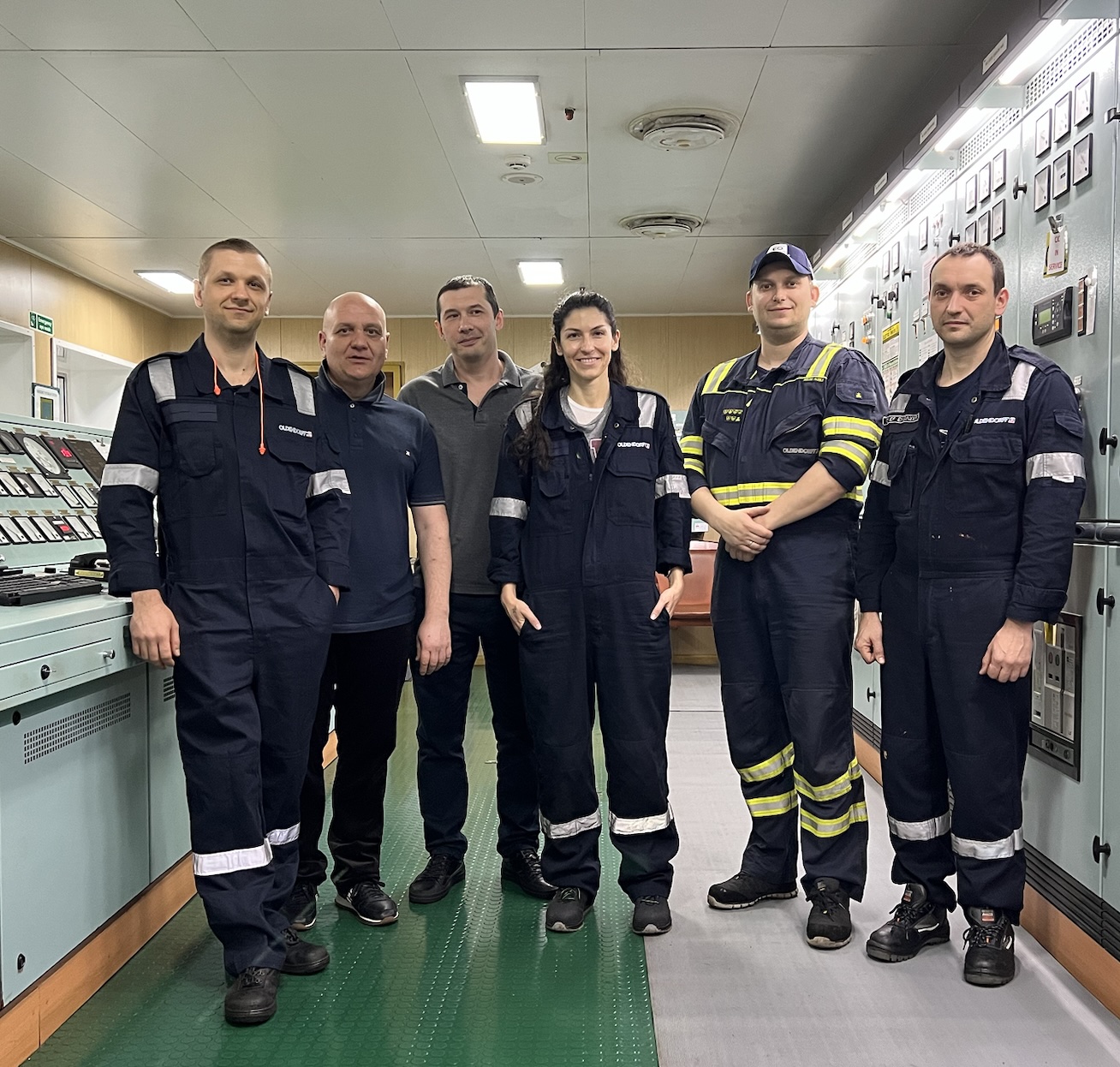In a collaboration, Professor Patricia Stathatou and her team at the Georgia Institute of Technology deployed onboard measurements and a comprehensive Well-to-Wake life-cycle assessment to compare heavy fuel oil with open-loop scrubbers versus low-sulfur alternatives, while MIT‘s Professor Neil Gershenfeld provided insight into the digital and systems-level innovations shaping next-generation shipping technologies. As part of our in-depth feature; which we covered in our earlier news story, we spoke with both experts to delve into their methodologies, key findings, and the broader implications for sustainable maritime engineering. The paper can be found here:
Stathatou, P. M., Petrunia, I., Barenthin, T., Gotsis, G., Jeffrey, P., Fee, C., Bergeron, S., Tsezos, M., Triantafyllou, M., & Gershenfeld, N. (2025). Marine Scrubbers vs Low-Sulfur Fuels: A Comprehensive Well-To-Wake Life Cycle Assessment Supported by Measurements Aboard an Ocean-Going Vessel. Environmental Science & Technology, 59(14), 7066–7080. https://doi.org/10.1021/acs.est.4c10006
Follow some of the authors here:
- Patricia Stathatou | Linkedin
- Ievgenii Petrunia | Linkedin
- Torsten Barenthin | Linkedin
- Neil Gershenfeld | Linkedin
- Michael Triantafyllou | Linkedin
The other authors included: George Gotsis, Paul Jeffrey, Christopher Fee, Scott Bergeron and Marios Tsezos.
The following interview is presented unedited to preserve their original responses and give you an unfiltered look at the cutting-edge research driving cleaner, more efficient shipping.
Acknowledgments: The authors are grateful to the Master, Konfederatov Evgeni, and the core technical team of the Hedwig Oldendorff vessel, Liashko Igor (Chief Officer), Omelyanenko Ivan (Chief Engineer), and Zaytsev Serhiy (2nd Engineer), for their tremendous support during the onboard measuring campaign. They are also thankful to Jan Kohzer, Sustainable Manager of the Global Engagement and Sustainability Department at Oldendorff Carriers, for arranging the logistics and scheduling the onboard campaign. The authors would like to thank Yara Marine Technologies (Alexander Holm, Fleet Technology Specialist) for providing detailed information on the scrubber production and manufacturing process. The authors are also thankful to Tyler Beck from Dekati for his valuable input on the optimal operation of the eDiluter Pro system onboard the vessel. P.M.S. is also grateful to Dr. Nga Lee (Sally) Ng from Georgia Tech and Dr. Konstantinos Goulas from Oregon State University for the fruitful discussion and input regarding scrubber NOx emissions. Last but not least, P.M.S. is grateful to co-authors Marios Tsezos, George Gotsis and their team from Naias Labs in Greece who contributed significantly to the research.
Could you explain the main methodologies and metrics used in your lifecycle assessment to compare heavy fuel oil with scrubbers versus low-sulfur fuels for maritime shipping?
We used a Well-to-Wake life cycle assessment (LCA) to compare the environmental impacts of using heavy fuel oil (HFO) with an open-loop scrubber versus low-sulfur fuels, i.e., marine gas oil (MGO) and very low-sulfur fuel oil (VLSFO) on a bulk carrier ship.This approach is providing a comprehensive, cradle-to-grave perspective. It covers the entire lifecycle of each fuel option and the scrubber, from resource extraction, production, and distribution (Well-to-Tank) to the actual use of the scrubber and the fuels onboard the vessel (Tank-to-Wake). We combined these to get the Well-to-Wake LCA results.
A unique feature of our study is that we collected onboard emissions data – both air emissions (e.g., CO₂, SO₂, NOx, PM2.5) and washwater discharges (when the scrubber was operating) – while the vessel operated on all three fuels, under similar weather conditions and engine modes. We used these measurements to calculate impacts across several environmental categories and relevant indicators, including greenhouse gas emissions, photochemical ozone formation, terrestrial acidification, and fine particulate matter formation. We also analyzed the chemical composition of the scrubber’s washwater and compared the results against some of the strictest U.S. and EU industrial discharge limits as well as aquatic life protection criteria.
How do the operational profiles of different vessels (e.g., tanker, container ship, bulk carrier) affect the overall effectiveness and emissions benefits of using scrubbers versus low-sulfur fuels?
Our study focused on large, ocean-going bulk carriers, which represent over 20% of the global merchant fleet and can contribute significantly to maritime emissions. This vessel type was selected due to its prevalence and significant fuel consumption. We evaluated scrubber performance under multiple engine operating modes, ranging from idle to 80% of maximum continuous rating (MCR), to reflect varied operational profiles of bulk carriers. Our findings show that open-loop scrubbers operating on HFO can match or outperform low-sulfur fuels across several life cycle impact categories. In addition, in all cases, both the raw and conservatively diluted scrubber washwater concentrations were well below regulatory thresholds, suggesting low risk to marine ecosystems when used in open-sea conditions.
Operational profiles do vary across vessel types and sizes. For example, larger bulk carriers (e.g., vessels exceeding 100,000 deadweight tons – DWT) tend to spend more time in long sea passages and less time at ports, which increases the proportion of time scrubbers can be operated. In contrast, smaller vessels such as handy-size bulk carriers (~38,000 DWT) spend more time in coastal waters and ports, where the use of open-loop scrubbers is increasingly restricted. These regulatory limitations, coupled with the fact that most bulk carriers are not equipped with hybrid or closed-loop systems, reduce the operational time of scrubbers and thus their overall effectiveness and emissions benefits for certain routes or ship sizes. Other vessel types, like tankers and container ships, may exhibit different operational patterns as well.
While our results show the environmental competitiveness of open-loop scrubbers under realistic operating conditions for large bulk carriers, we recognize that vessel type, size, route, and regulatory constraints play an important role in determining their overall effectiveness. Future measurement-informed LCAs tailored to other vessel classes, such as tankers or container ships, will be essential to fully evaluate the trade-offs between scrubbers and low-sulfur fuels across the global fleet.
What specific chemical or process engineering challenges arise when integrating scrubbers into existing ship systems, and how might these challenges influence the true cost and feasibility of retrofitting?
For conventional open-loop scrubbers, there are generally no significant chemical or process engineering challenges during integration into existing ship systems, particularly for retrofits on larger vessels where space and power capacity are less constrained. The situation may become more complex with hybrid or closed-loop scrubber systems, which may require additional components for washwater treatment and chemical handling. However, potential engineering challenges and factors affecting the cost and feasibility of retrofitting such scrubber systems fall largely outside the scope of our study.
Could you discuss the potential environmental trade-offs in the discharge of washwater from scrubbers, particularly in sensitive marine ecosystems?
The measured concentrations of trace metals, PAHs, and other potentially concerning compounds in scrubber washwater were all below strict US and EU industrial discharge limits. Nutrient levels were also very low, with total nitrogen and phosphorus concentrations well below even the most stringent thresholds for sensitive water bodies (e.g., 3 mg/L for total N and 0.1 mg/L for total P).
To assess potential risks to marine ecosystems, we conservatively assumed a static 1,000-fold dilution after discharge and found that resulting pollutant concentrations in receiving waters remained well below environmental quality standards. While some studies have observed ecotoxicity effects from scrubber washwater under undiluted or weakly diluted conditions, such scenarios are unlikely in open-sea environments where dilution occurs rapidly; washwater can be dilluted hundreds of thousands of times immediately after discharge, and by millions over time. One recent study reported that the no-effect concentration for green sea urchin larvae would require dilutions exceeding 1,000,000-fold. Given that observed effects occur over extended exposures and that marine organisms can move between water masses, adverse impacts under real-world, open-ocean conditions appear unlikely.
However, this may not be the case in confined spaces with higher traffic and lower water exchange rates, such as ports, where the dilution and dispersion of the released compounds are limited. In such areas, the discharge of scrubber washwater might lead to localized accumulation of pollutants, thereby increasing the risk of adverse impacts on aquatic ecosystems particularly in sensitive regions. Therefore, additional experimental data on scrubber discharges over longer periods and under various conditions are needed to assess their short- and long-term whole effluent toxicity, under realistic dilutions, following reliable risk assessment methodologies.
In your study, what role do maintenance and long-term reliability issues play in the overall viability of scrubbers, especially given variable global regulations and port requirements?
We did not assess maintenance practices, long-term operational reliability, or compliance with variable port regulations, as these factors involve engineering, economic, and policy considerations beyond the environmental performance metrics covered in our analysis.
How does the initial capital investment and ongoing operational expense of installing and running scrubbers compare to the cost of sourcing and using low-sulfur fuels over a vessel’s lifetime?
While our study did not include an economic assessment of scrubber installation, operation, or maintenance compared to the lifetime cost of sourcing low-sulfur fuels, the rapid increase in scrubber adoption – from fewer than 800 vessels in 2018 to approximately 6,000 by 2024 – indicates that many ship operators view scrubbers as a cost-effective solution. Industry experience supports this perspective: the consistent and significant price spread between high-sulfur fuel oil (HFO) and low-sulfur fuel oil (LSFO) over the past several years has made scrubber investments commercially attractive. According to our industry partners, this price differential allowed many operators to recover their capital expenditures relatively quickly, making scrubbers a financially viable strategy. While the fuel price spread has narrowed somewhat in recent years, the scrubber investments on many ships have already paid off, reinforcing the commercial case for their use.
Looking ahead, what are the key areas of research you and your team plan to explore next, and are there any industry collaborations or pilot projects underway to validate your findings in real-world shipping scenarios?
My group at Georgia Tech is focusing on advancing sustainable transportation, including shipping, with a particular focus on alternative fuels and their lifecycle impacts. We have several new projects launching in the coming months that will explore the environmental performance of emerging energy carriers and propulsion systems.

Hassan graduated with a Master’s degree in Chemical Engineering from the University of Chester (UK). He currently works as a design engineering consultant for one of the largest engineering firms in the world along with being an associate member of the Institute of Chemical Engineers (IChemE).



